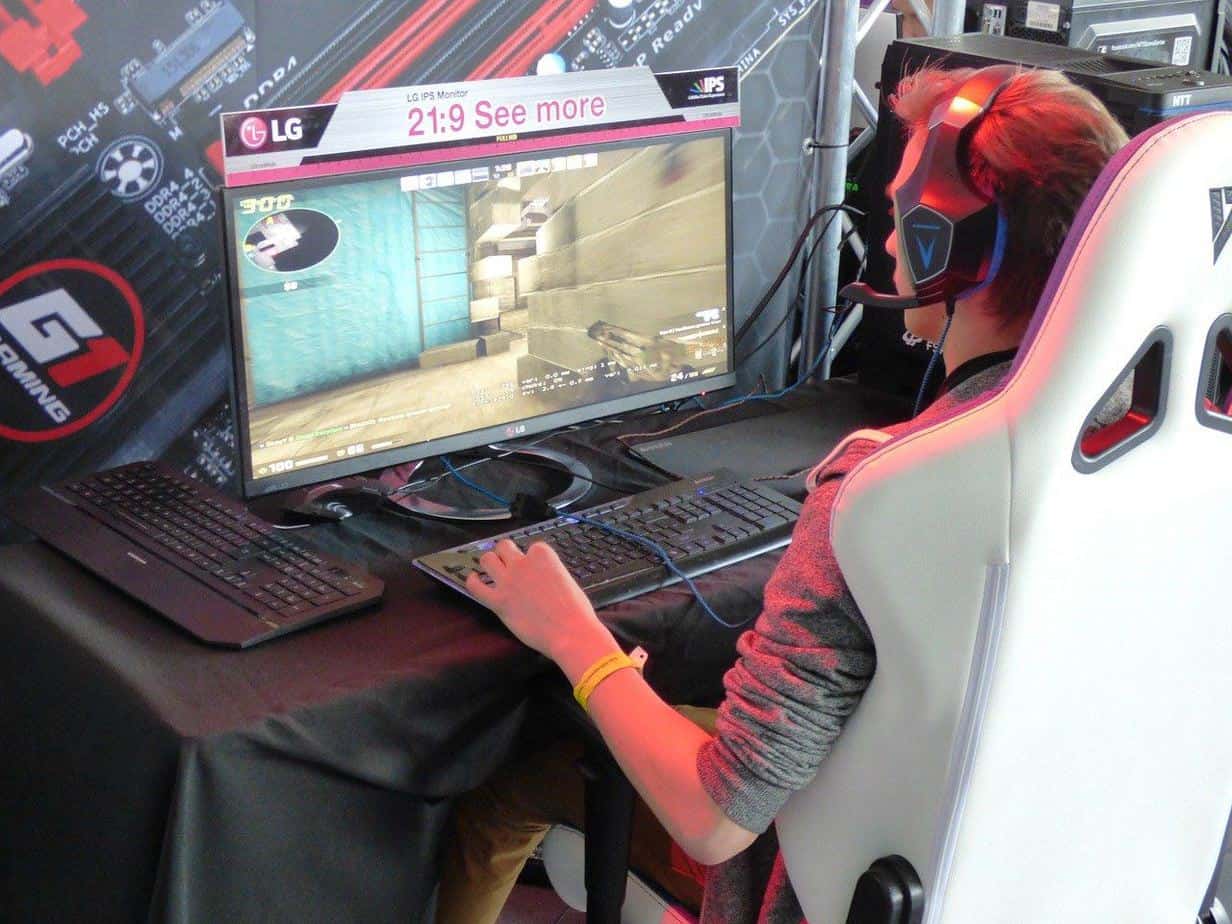
Serious gamers today know that the monitor that they use makes a world of difference when it comes to their gaming experience – and not just from a graphical standpoint, either.
The right gaming monitors can make all the difference when it comes to performance, especially when you are playing particularly competitive titles in genres like the FPS world.
The wrong gaming monitor, on the other hand, can tank your odds of success faster than you ever would have thought possible.
And while there are a lot of monitors that hit it out of the park when it comes to overall resolution output and high-speed refresh rates, the unfortunate reality is that most gaming monitors compromise in one of these areas or the other to keep prices (relatively) low.
Which one should you consider compromising on for your next gaming monitor? We dig a little deeper into that below!
Refresh Rate vs Resolution – Which Is Most Important for Gaming?
Up until a handful of years ago (5-8 years ago, maybe) the majority of gamers wanted only highest resolution possible out of their gaming systems.
They wanted graphics that would melt lesser hardware, the kinds of graphics that games like Crysis delivered – a game more than 15 years old now, but one that continues to strain some of the most well-built and cutting edge gaming PCs even still today.
The resolution was absolutely everything!
It sounds crazy now, but 10 or 15 years ago HD TVs were still relatively brand-new, HD signals coming over the satellite or cable box were foolishly expensive, and most people still had DVD collections and not Blu-ray.
Streaming in high-resolution wasn’t even a serious consideration.
As time went on, though, and high-resolution hardware became less expensive, and more widespread gamers stopped focusing exclusively on whether or not their games ran the intended 1080p or 4K.
Instead, the focus shifted almost completely to refresh rates, and that’s where the bulk of the gaming world is focused on still today.
Gamers are always looking for monitors that push refresh rates faster and faster, monitors that can take full advantage of today’s supercharged GPUs to get refresh rates that get up to 240 Hz – if not even faster.
Because the gaming hardware world responds to customer demand more than anything else (just like game developers are), not to mention that the leap from 4K to 8K resolution is nothing like the jump from 720p to 4K, makes a lot more sense to focus on refresh rate if you can.
How Important is Refresh Rate?
Believe it or not, there are still some gamers out there that feel refresh rates – especially anything over 60 Hz – are nothing more than “voodoo” and marketing mumbo-jumbo used to sell overly expensive panels and monitors.
If you have been a gamer for any amount of time you’ve likely heard people in the community say “humans can’t see anything above 60 Hz refresh rates anyway”.
We can tell you (beyond a shadow of a doubt) that nothing could be further from the truth. Refresh rate is absolutely everything when it comes to squeezing each drop of performance out of your gaming hardware these days.
Let’s break this down with a quick example:
Say you are playing a particularly resource-intensive game on the PC (maybe the latest Assassin’s Creed game on High).
But because you are playing on a souped-up PC you build yourself (one with a cutting edge GPU) you’re able to get 90 FPS and higher without much trouble.
Unfortunately, though, you are playing on a monitor that has a high-end refresh rate of 60 Hz. This means that your display is only going to show 60 FPS even though it’s capable of 30 frames per second more – and that’s something you’re going to notice for sure.
Bump that display up to 120 Hz refresh rate, though, and all of a sudden your game looks smoother, more fluid, and a whole lot more engaging.
That’s the difference that refresh rate makes!
Motion Resolution – What’s That All About?
Another reason to focus on the refresh rate of your monitor versus the resolution is capable of producing has to do with “motion resolution”.
Motion resolution is basically what your eyeballs see when there’s a lot of movement on your computer screen.
With a high refresh rate (120 Hz or 240 Hz) you are going to see absolutely zero noticeable differences in the sharpness or overall resolution of the images at nearly any frame)
With low refresh rate monitors (60 Hz) you’re going to see a lot more tearing and a lot more “skipping” – even if your monitor is still maintaining that 4K resolution.
Some people can perceive these differences more than others, and some can tell the difference at all. It really comes down to your personal experience with “motion resolution”.
We can tell you, though, that if you’re one of the overwhelming majority that can notice the difference it’s going to have a huge impact on whether or not you enjoy your gaming sessions.
The higher the refresh rate on your gaming monitor the smoother your action is going to be.
That’s not only a big deal for competitive genres like first-person shooters (FPS), but it also makes standalone, single-player, or RPG titles feel a lot more immersive and more cinematic.
Minimalizing Screen Tear is Critical
The bulk of today’s gaming monitor manufacturers recognize how important it is to synchronize (as much as possible) refresh rates and resolutions, even if they aren’t able to get a true 1:1 matchup most of the time.
You are likely going to have to deal with some discrepancies, and those discrepancies are almost always going to create “screen tear”.
This is what happens when your computer is capable of pumping out far more frames per second than what your monitor can recognize.
Because the frames are being rendered faster than your monitor can handle, half frames, quarter frames, or fractional frames are jumbled up with everything else – and all of a sudden your game looks like a nightmare.
To minimize screen sharing as much as possible you’re going to want to match your monitor to your hardware as best you can.
If you’re going to go for a real high horsepower kind of graphics card you need to be sure that your budget can support a gaming monitor that can handle its output.
Get this mixed up (or ignore it completely) and all that hardware – and your gaming budget – is going to go to waste. Try to play while your screen is tearing every few frames is almost impossible.
Synchro Tech is Hugely Important
Of course, another way to kind of minimalize screen tearing caused by the differentiation of resolutions and refresh rates is to invest in monitors that include frame synchronization technology.
There are a couple of different proprietary synchronization technologies out there (including FreeSync, G Sync, and V Sync) but all of them are responsible for doing basically the same thing under the hood of your monitor.
Synchronization options work to sort of “throttle” the number of frames your hardware can put out, making sure that your monitor never becomes overloaded or overburdened.
It results in a much smoother and more enjoyable experience for sure, but again you end up sacrificing some performance on the refresh rate side of things if your monitor just can’t keep up.
Do Skyhigh Refresh Rate Monitors Make a Difference?
At the end of the day, if you are serious about making sure that your gaming monitor looks great and performs as best it can you’ll want to cheat a little bit towards the refresh rate side of things compared to overall resolution.
Sure, 4K panels look absolutely fantastic when you have graphics and texture settings on high.
But the difference in overall playability between those kinds of settings with 60 Hz and a 1080p monitor with a 120 Hz refresh rate is night and day – especially online and especially in more competitive gaming genres.
If you’re going to be playing single-player only, role-playing style games where the graphics are a huge piece of the puzzle (like the Crysis game series) then by all means dropping a mountain of money on gaming monitors with insane resolutions.
If, on the other hand, you really want to unleash the full power of your gaming PC – really pushing it to its limits and maximizing your investment in your gaming hardware – then you are going to want to splash a little extra cash on gaming monitors with higher refresh rates.
60 Hz refresh rates should be the absolute bare minimum when you are shopping for a monitor, and ideally, you are going to be looking at 1080p monitors with 120 Hz refresh rates.
If you have a budget that allows you to bump that up to 1080p monitors with 240 Hz refresh rates all the better. And if you are really lucky, a 4K resolution monitor with a 240 Hz refresh rate is like the Holy Grail.
References
https://mollylab-1.mit.edu/sites/default/files/documents/FastDetect2014withFigures.pdf
https://www.digitaltrends.com/computing/do-you-need-a-120hz-or-240-hz-monitor/
https://www.reddit.com/r/pcmasterrace/comments/85jfu3/refresh_rate_vs_resolution/
